객체망을 구성할 때는 의존성이 양방향이 되지 않도록 하는 것이 중요하다.
가장 중요한 pattern 은 abstract factory method pattern, command pattern이다.
합성과 의존성
객체망을 구성할 때, 의존성 없이 객체 망이 될 수 없으므로 그만큼 의존성 관리가 중요하다.
하지만 적절한 의존성 관리라는 건 명확하지 않으므로 의존성의 방향이 양방향으로 되지 않도록 주의 해야 한다.
합성이나 상속 할 때 의존성의 방향 때문에 많은 문제가 일어난다.
그래서 이러한 의존성 문제를 해결하는 방법과
design pattern 중 template method pattern 과 strategy pattern 통해서 합성과 상속의 차이까지 알아본다.
Template method
abstract class DiscountPolicy {
private Set<DiscountCondition> conditions = new HashSet<>();
public void addCondition(DiscountCondition condition) {
conditions.add(condition);
}
public Money calculateFee(Screening screening, int count, Money fee) {
for (DiscountCondition condition : conditions) {
if (condition.isSatisfiedBy(screening, count)) return calculateFee(fee);
}
return fee;
}
protected abstract Money calculateFee(Money fee);
}
DiscountPolicy 에 대해서 Template method pattern 을 적용했다.
calculateFee 가 Template method 로 작동하면서 abstract method 를 통해 hook 을 발생시키고 있다.
Template method pattern 은 일반적인 상속과 다르게 의존성의 방향이 보다 추상화된 쪽을 역전시키려고 하기 때문에 중요하다. 일반적인 상속을 하면 의존성의 방향이 자식이 부모를 가리키게 되면서 의존성이 굉장히 넓게 퍼져서 문제가 나타난다. 부모 수정의 여파가 모든 자식에게 가기 때문에 일반적인 상속은 사용하면 안된다.
하지만 Template method pattern 은 부모와 자식간의 관계를 역전 시킨다.
부모가 abstract method 를 interface 처럼 사용하여 부모가 자식을 알고 있게 되고 자식은 책임만 구현하면 된다.
자식은 독립된 인터페이스를 구현하고 부모가 자식의 interface 의존하기 때문에 수정이 서로에게 영향을 미치지 않는다.
public class AmountPolicy extends DiscountPolicy {
public final Money amount;
public AmountPolicy(Money amount) {
this.amount = amount;
}
@Override
protected Money calculateFee(Money fee) {
return fee.minus(amount);
}
}
Template method pattern 을 이용하여 AmountPolicy 를 만들었다.
AmountPolicy 는 calculateFee 만 구현하고 부모를 전혀 사용하지 않는다.
자식들은 부모의 지식을 함부로 사용하지 않고 미리 확정되어 있는 protocol 만을 이용해서 통신을 하고 있고 hollywood 원칙(Tell Don’t Ask)을 지키고 있다.
getter 로 이용해서 어떤 동작을 하지 않고 서로 시키고 있다.
자식에서 private 가 아닌 protected 로 선언된 부모의 내부 속성이나 getter, setter 를 쓰고 있다면 좋지 않은 상속이다.
객체망에서 자식 객체를 생성하면 실제로 부모 객체도 하나의 포인터로 관리될 뿐이지 힙 메모리에 따로 저장된다.
그래서 별개의 객체라고 생각하고 서로 interface 로 통신을 해야한다.
Strategy
template method pattern 을 strategy pattern 로 변경한다. 안정화되고 상속층으로 만들어도 될 거 같다면 template method pattern 을 사용하고, 유연하게 더 연결될 수 있을 것 같다면 strategy pattern 을 사용한다. 보통은 strategy pattern 으로 시작해서 유연성을 충분히 확보하고 안정화 됐다고 생각하면 template method pattern 으로 변경한다.
public class DiscountPolicy {
private final Set<DiscountCondition> conditions = new HashSet<>();
private final Calculator calculator;
public DiscountPolicy(Calculator calculator) {
this.calculator = calculator;
}
public void addCondition(DiscountCondition condition) {
conditions.add(condition);
}
public Money calculateFee(Screening screening, int count, Money fee) {
for (DiscountCondition condition : conditions) {
if (condition.isSatisfiedBy(screening, count)) return calculator.calculateFee(fee);
}
return fee;
}
}
strategy pattern 상에서는 합성의 원리를 사용하게 되므로 calculateFee 를 처리하는 calculator 를 소유 하게 된다.
그래서 DiscountPolicy 는 외부 객체의 도움을 받는 단일 클래스가 되었다.
public class AmountCalculator implements Calculator {
public final Money amount;
public AmountCalculator(Money amount) {
this.amount = amount;
}
@Override
public Money calculateFee(Money fee) {
return fee.minus(amount);
}
}
calculator 를 상속받은 AmountCalculator 가 calculateFee 라는 interface 를 구현한다.
코드는 거의 동일하지만 상속을 이용하지 않고 interface 로 통신할 뿐이다.
template method pattern 이 하는 일을 정확하게 strategy pattern 으로 변경할 수 있다.
public class AmountPolicy extends DiscountPolicy {
public final Money amount;
public AmountPolicy(Money amount) {
this.amount = amount;
}
@Override
protected Money calculateFee(Money fee) {
return fee.minus(amount);
}
}
두가지 pattern 을 비교해서 보면 결국, DiscountPolicy 라는 부모는 Calculator 의 역할을 하고 있었던 것이다.
즉, abstract class 를 interface 처럼 protocol 로 사용하고 있었던 것이다.
이처럼 abstract class 를 interface 처럼 사용해야 상속을 잘 사용하는 것이고 잘 만들어진 추상 layer 는 strategy pattern 로 쉽게 변경할 수 있다.
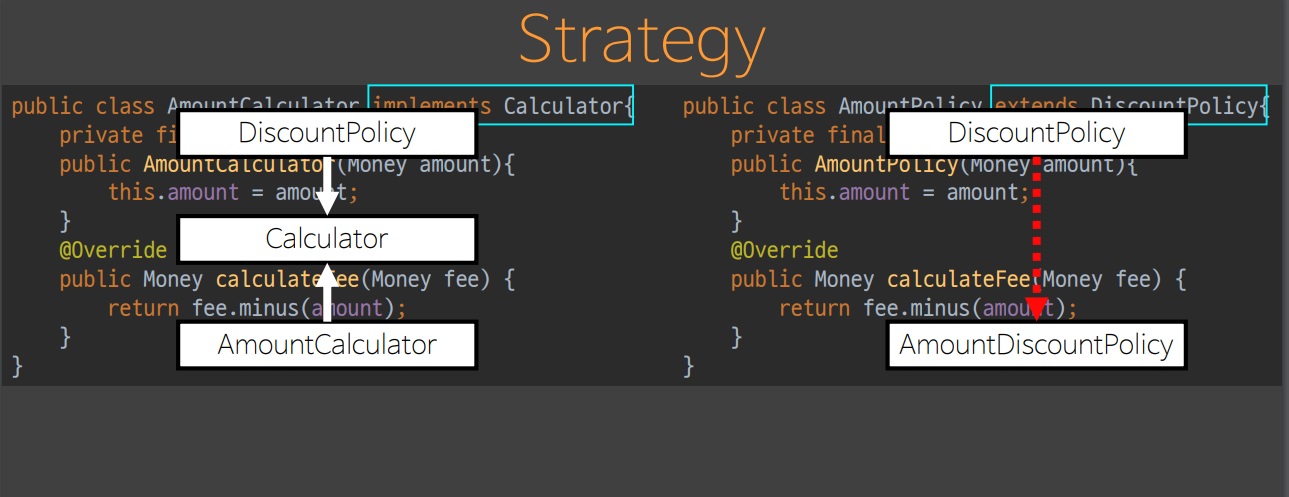
상속을 사용해서 template method pattern 을 사용할 때 장점은 의존성 관계가 단순해진다.
관계가 DiscountPolicy 와 상속 받고 있는 AmountPolicy 밖에 없고 의존성도 역전 되었다.
strategy pattern 에서는 DiscountPolicy 가 AmountCalculator 를 직접 모르게 하기 위해서 중간에 Calculator 를 끼워 넣어 단방향 의존성을 해결 했다.
DiscountPolicy 의 무거운 역할이 Calculator 에게 옮겨지지만 수정이 어려워진다.
즉, interface 에 대한 확신 없이 전략 패턴을 도입하면 여파가 오게 된다.
strategy pattern 을 쓰면 template method pattern 과 굉장히 유사해 보이지만 차이점이 존재한다. strategy pattern 에서는 strategy layer 이라는 것이 생겨서 충격을 흡수함과 동시에 무거워진다. template method pattern은 추상 메소드에 대한 무게가 생긴다.
처음부터 정립된 domain 을 파악하기 힘들기 때문에 관계도를 분리해서 strategy layer가 여파를 흡수하도록 하여 유연성을 확보하고, template method pattern을 통해서 관계를 단순화 시키고 방향성을 고정시킨다.
Template Method & strategy
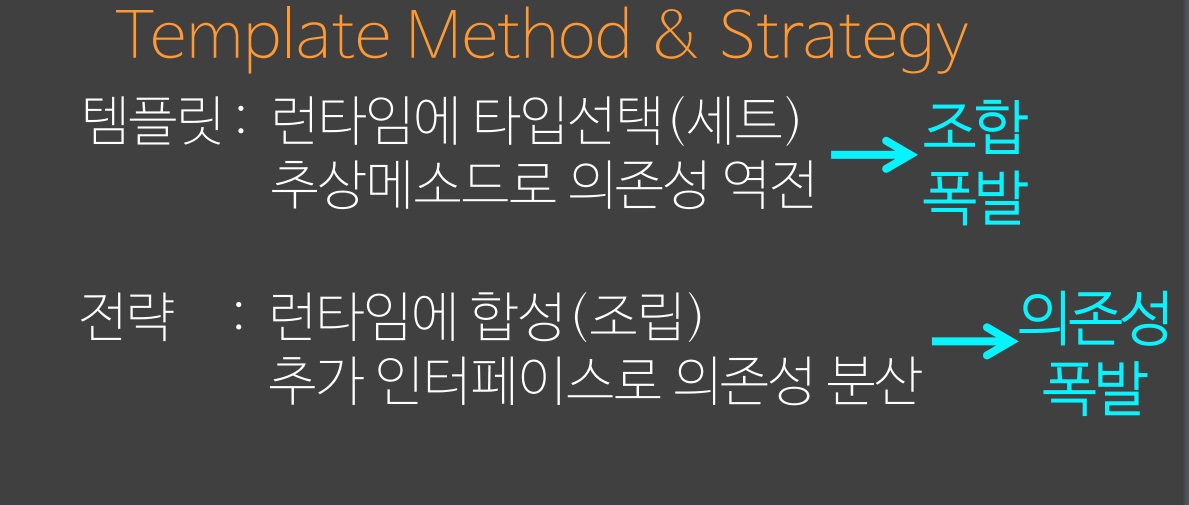
template method 를 사용하게 된다면 if 를 통해서 원하는 class 를 선택하는 거에 비해
strategy 은 DiscountPolicy를 생성하고 합성해야 할 객체를 if 를 통해서 생성해야 한다.
strategy pattern은 pointer 의 pointer 를 원리를 이용하게 되므로 Runtime 에 언제든지 Calculator 를 바꿀 수 있지만 template method pattern 은 형 자체를 변경해야 한다.
각 pattern 에는 단점이 존재한다. template method pattern 은 자식이 중첩 구조인 경우에 조합할 수 있는 경우의 수가 계속 늘어나게 되서 조합 폭발이 발생한다. 상속을 이용해서 세트를 만들었기 때문에 조합 폭발이 일어난다.
이에 비해 합성은 Runtime 에 필요한 것들만 넣어주면 되므로 조합 폭발이 일어나지 않지만 의존성이 폭발한다. 관계에 대해 알아야 되는 경우의 수만큼 들어오기 때문에 의존성 폭발이 발생한다.
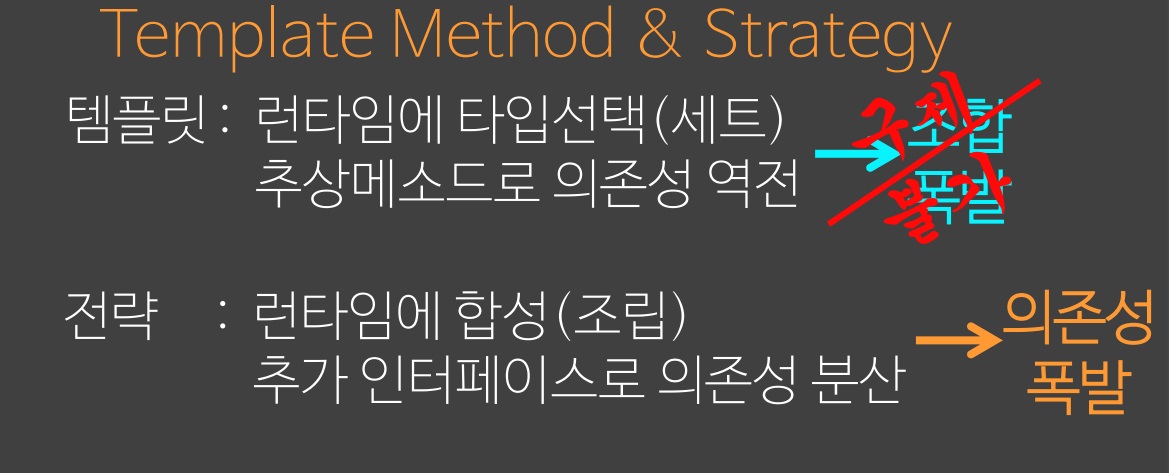
template method pattern를 사용해도 상속의 문제가 해결되지 않는다. 하지만 strategy pattern에서의 의존성 폭발은 해결할 수 있다. template method pattern은 조합 폭발이 일어나는 것이 확정이기 때문에 strategy pattern 의 의존성 폭발을 해결 하는 방법을 알아본다.
생성 사용 패턴과 팩토리
생성 사용 패턴이라는 것은 객체를 만들기 위한 코드와 사용하는 코드가 있다는 것이다. 생명주기도 틀리고 관리하기 힘들기 때문에 이 두 코드를 병행해서 사용하면 안된다.
생성 사용 패턴
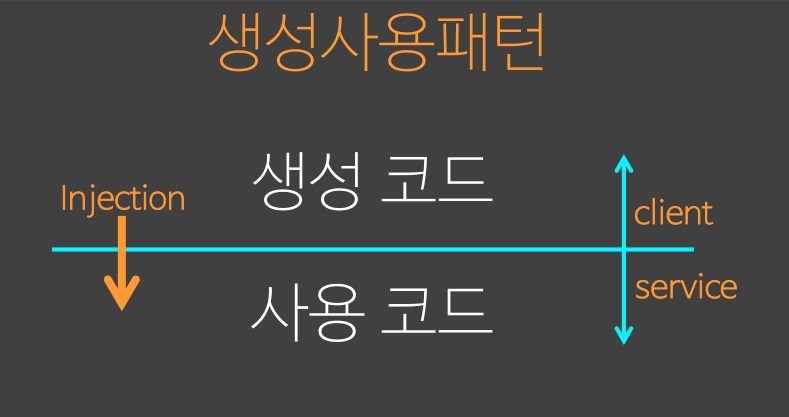
생성 사용 패턴 이용해서 생성 코드와 이용 코드를 구분하고 client 쪽으로 밀어내서 service 코드를 줄이도록 한다. 그러면 client 에서 service 쪽으로 객체를 주입할 수 밖에 없는 일이 생긴다.
Injection

Calculator 는 바깥쪽에서 주도적으로 주입되었다.
Injection이 좋아 보이지만 바깥쪽에서 강제로 주입 당하고 있기 때문에 독립된 책임과 역할을 가지고 있던 DiscountPolicy이 제어권을 상실하게 된다.
Factory
interface CalculatorFactory {
Calculator getCalculator();
}
그래서 제어권을 역전하기 위해서 factory 를 만든다.
이 factory 는 원할 때 Calculator를 주는 지연 함수 같은 interface 가진다.
public class AmountCalculatorFactory implements CalculatorFactory {
public final Money money;
private AmountCalculator cache;
public AmountCalculatorFactory(Money amount) {
this.money = amount;
}
@Override
synchronized public Calculator getCalculator() {
if (cache == null) cache = new AmountCalculator(money);
return cache;
}
}
pushed 를 제거하고 객체를 원하는 시점에 특정 동작을 넣기 위해 factory 를 도입한다.
factory 를 구현하고 있는 AmountCalculatorFactory 를 보면 외부에서 AmountCalculator 를 원할 때 만들어서 제공하고 있고 내부에서는 cache 정책도 사용한다.
게다가, synchronized 로 선언하여 multi thread 에서도 원활하게 동작한다.
Lazy Pull
public class DiscountPolicy {
private final Set<DiscountCondition> conditions = new HashSet<>();
private final CalculatorFactory supplier;
public DiscountPolicy(CalculatorFactory supplier) {
this.supplier = supplier;
}
public void addCondition(DiscountCondition condition) {
conditions.add(condition);
}
public Money calculateFee(Screening screening, int count, Money fee) {
for (DiscountCondition condition : conditions) {
if (condition.isSatisfiedBy(screening, count)) {
return supplier.getCalculator().calculateFee(fee);
}
}
return fee;
}
}
DiscountPolicy 는 본인이 원할 때 호출할 수 있도록 factory로 주입 받는다.
원할 때, Calculator 를 사용하게 되었지만 pointer 의 pointer 를 사용하고 있기 때문에 DiscountPolicy 는 Factory 가 어떤 Calculator 를 주고 있는지는 모르게 된다.
지연 연산을 통해 Runtime 에 다른 Calculator 를 받을 수 있는 가능성을 갖고 있는 것이다.

그런데 여기에는 디미터법칙을 위반하는 (열차 전복 사고) 문제가 있다.
DiscountPolicy 는 필드나 속성에도 Calculator 에 대한 정보가 없지만 Calculator 지식을 사용하고 있다.
단순하게 객체를 반환하는 Factory 는 무조건 디미터의 법칙을 위반한다.
디미터 법칙 위반을 해결하기 위해 우리는 DiscountPolicy 가 factory 와 calculator 를 동시에 알게 하거나 factory 만 알도록 한다.
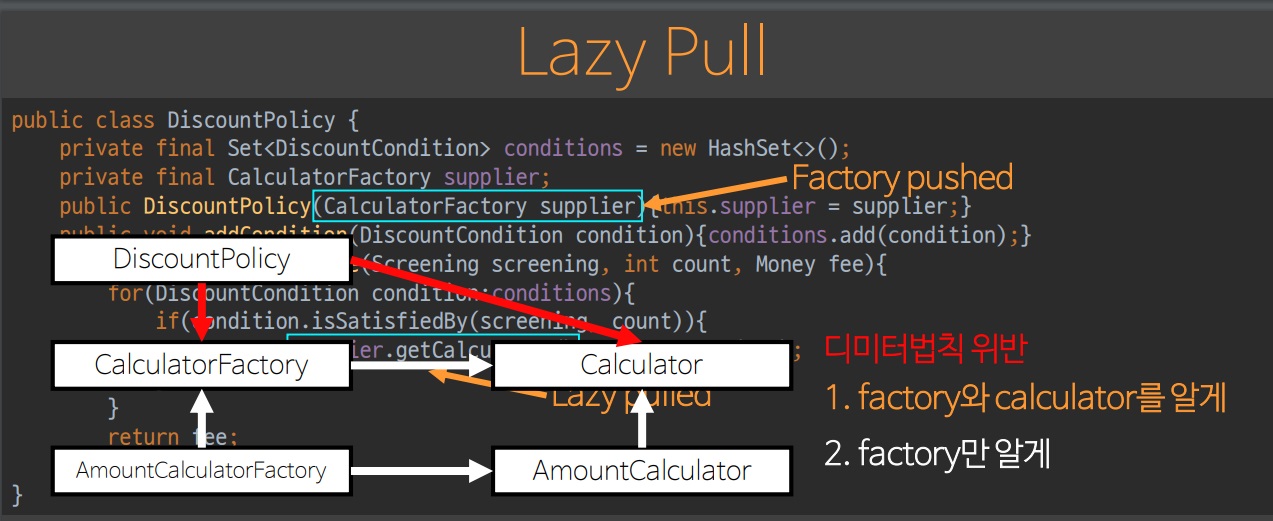
DiscountPolicy 에 지역 변수나 field 에 선언해서 factory 와 calculator 를 알게 한다면 위와 같은 관계도를 얻게 된다.
Factory 와 Calculator 추상 클래스와 구상 클래스들 순환 참조가 생긴다.
factory circulation 영역이 생겨서 양방향 참조가 성립하게 되서 simple factory 를 사용하면 안된다.
위임된 팩토리

그래서 factory에게 책임을 위임해서 factory 만 알도록 변경한다.
calculateFee 자체를 위임한다.
public interface CalculatorFactory {
Money calculateFee(Money fee);
}
public class AmountCalculatorFactory implements CalculatorFactory {
public final Money money;
private AmountCalculator cache;
public AmountCalculatorFactory(Money money) {
this.money = money;
}
synchronized public Calculator getCalculator() {
if (cache == null) cache = new AmountCalculator(money);
return cache;
}
@Override
public Money calculateFee(Money fee) {
return getCalculator().calculateFee(fee);
}
}
Calculator 의 지식이 factory 안으로 들어가게 되고 DiscountPolicy 는 factory 만 알 수 있게 된다.
이것을 위임된 factory 라고 한다.
순환 참조가 생기기 때문에 어쩔 수 없이 위임된 factory pattern 을 사용해야 한다.
public class DiscountPolicy {
private final Set<DiscountCondition> conditions = new HashSet<>();
private final CalculatorFactory supplier;
public DiscountPolicy(CalculatorFactory supplier) {
this.supplier = supplier;
}
public void addCondition(DiscountCondition condition) {
conditions.add(condition);
}
public Money calculateFee(Screening screening, int count, Money fee) {
for (DiscountCondition condition : conditions) {
if (condition.isSatisfiedBy(screening, count)) {
return supplier.calculateFee(fee);
}
}
return fee;
}
}
이렇게 되면 DiscountPolicy 코드를 줄일 수 있고 열차 전복 사고가 사라지고 디미터의 법칙을 지킬 수 있다.

위임된 factory를 사용했는데 factory 의 method 가 Calculator 와 동일하다.
결국, 위임된 factory는 구상 Calculator 자체가 되고 위임된 factory 의 interface 는 factoring 하려던 객체의 interface 와 일치 되는게 정상이다.
설계 중, 이 사실을 이해하지 못했다면 혼란이 왔을 것이다.
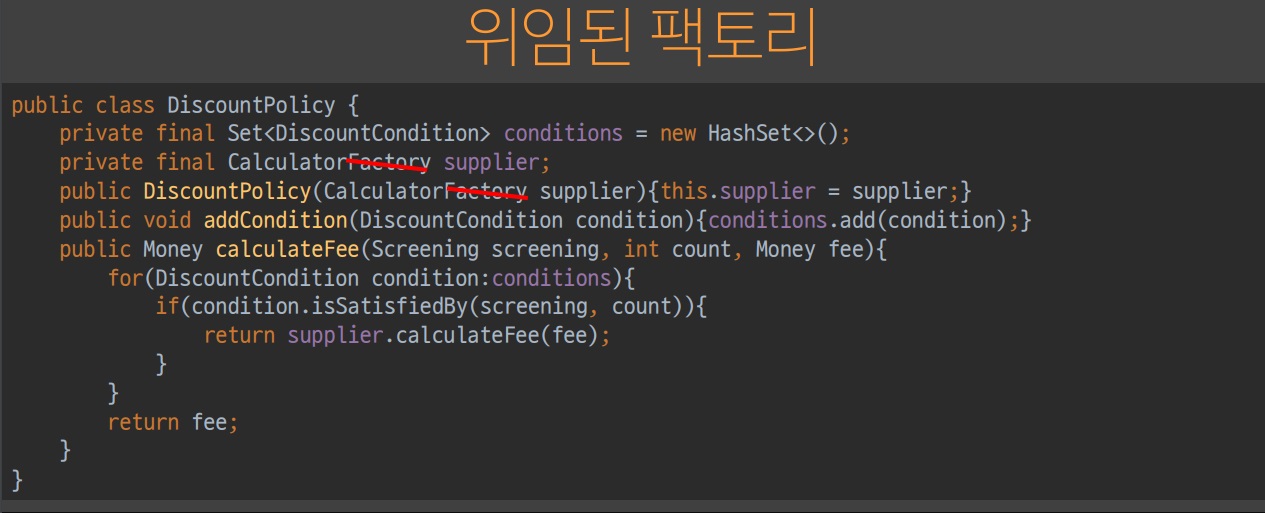
DiscountPolicy 도 결국 factory 를 참고할 필요가 없기 때문에 원래대로 돌아온다.
위임된 factory 은 factory 가 보이지 않는다는 것이 특징이다.
Calculator 를 위임했기 때문에 Calculator 와 똑같은 것이다.
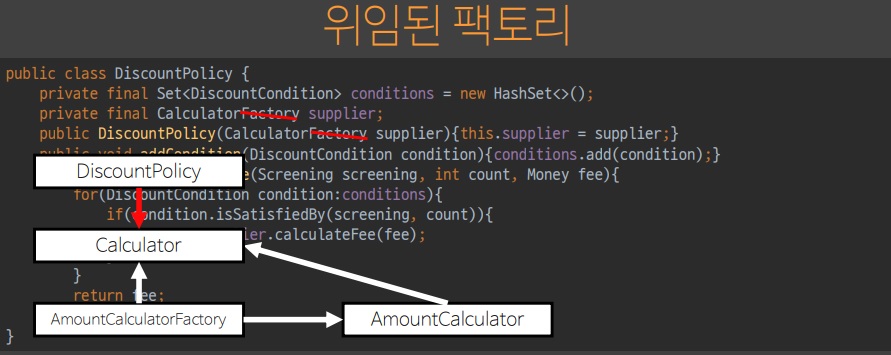
위임된 factory로 바꾸면 그림과 같은 관계도가 된다.
factory pattern 을 사용하여 Calculator 와 AmountCalculatorFactory 와 AmountCalculator 가 삼각형을 돌면서 순환참조가 생기는 것 같지만
AmountCalculator 의 역할이 AmountCalculatorFactory 로 겸하게 되니까 AmountCalculatorFactory 가 사라지게 된다.
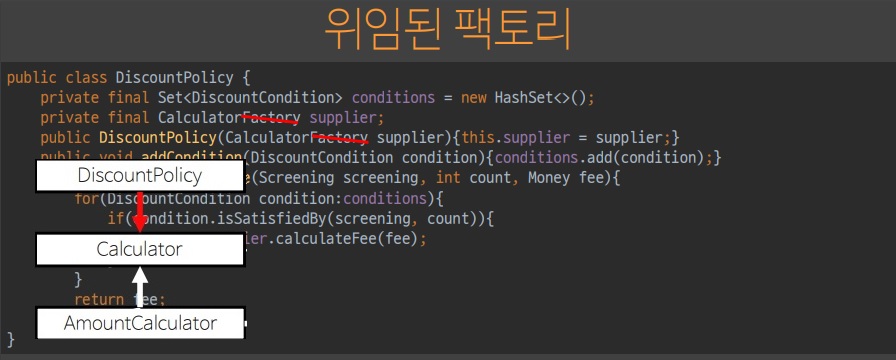
그래서 위임된 factory pattern 를 사용하면 한줄만 남게 되면서 순환이 없어진다.
추상 팩토리 메소드 패턴
abstract factory method는 의존성 폭발을 해결하기 위한 pattern 이기 때문에
factory 는 여러 객체를 반환할 수 있는 능력을 갖게 된다.

factory 에게 DiscountCondition 도 반환하도록 변경하고 DiscountPolicy 는 factory 만 알도록 한다.
factory 에서 공급받는 종류가 2가지가 된다.
DiscountCondition 위임
public interface PolicyFactory extends Calculator {
Set<DiscountCondition> getConditions();
}
public class AmountCalculatorFactory implements PolicyFactory {
public final Money money;
private AmountCalculator cache;
private final Set<DiscountCondition> conditions = new HashSet<>();
public AmountCalculatorFactory(Money money) {
this.money = money;
}
synchronized public Calculator getCalculator() {
if (cache == null) cache = new AmountCalculator(money);
return cache;
}
public void addCondition(DiscountCondition condition) {
conditions.add(condition);
}
public void removeCondition(DiscountCondition condition) {
conditions.remove(condition);
}
@Override
public Money calculateFee(Money fee) {
return getCalculator().calculateFee(fee);
}
@Override
public Set<DiscountCondition> getConditions() {
return conditions;
}
}
여러 가지 객체를 반환했으면 조합 폭발이 발생했겠지만 PolicyFactory는 Calculator 이면서 getCondition 만 보내면 되니까 간단하다.
지금은 discountPolicy 가 factory 한개만 알도록 하고 의존성을 AmountCalculatorFactory 에게 몰아준다.
사용 코드와 생성 코드가 나눠지고 DiscountPolicy 에는 사용 코드만 남았다.
의존성을 줄이기 위해서 abstract factory method을 사용했지만 열차 전복 사고를 주의 해야 한다.
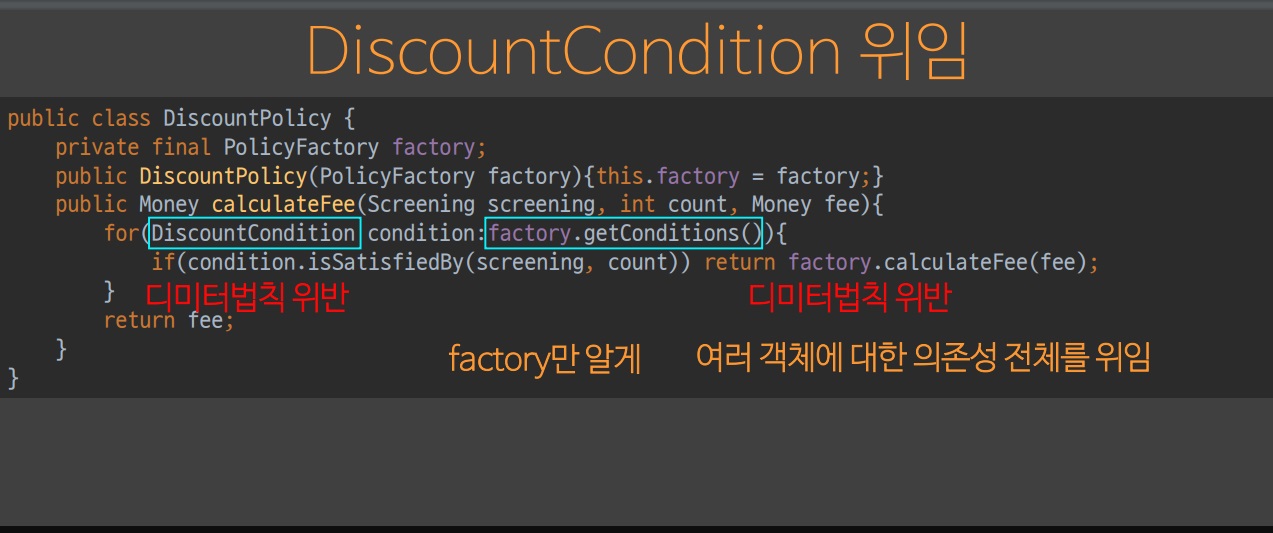
foreach 를 사용하기 때문에 conditions 에 대한 iterator method 호출로 열차 전복 사고가 내장되어 있다.
내부에서 iterator 를 호출하기 때문에 디미터의 법칙을 위반한다.
게다가 DiscountCondition 도 모르기 때문에 2중으로 디미터의 법칙을 위반하고 있다.
foreach 사용하는 부분을 위임하여 디미터의 법칙을 해소한다.
public interface PolicyFactory extends Calculator {
default Money calculatorFee(Screening screening, int count, Money fee) {
for (DiscountCondition condition : getConditions()) {
if (condition.isSatisfiedBy(screening, count)) return calculateFee(fee);
}
return fee;
}
Set<DiscountCondition> getConditions();
}
Policy의 공통 로직을 factory 에 위임하기 때문에 interface 에서 default method 로 구현한다.
Factory 는 Condition 을 알고 있었기 때문에 디미터의 원칙을 지킬 수 있고 template method 를 사용하게 되었다.
template method 에서 2가지 hook 을 사용 하는데 Factory에 조합 폭발이 미뤄진 것이다.
public class DiscountPolicy {
private final PolicyFactory factory;
public DiscountPolicy(PolicyFactory factory) {
this.factory = factory;
}
public Money calculateFee(Screening screening, int count, Money fee) {
return factory.calculateFee(screening, count, fee);
}
}
그래서 DiscountPolicy 는 결국 factory 를 받아서 calculateFee 를 위임한다.
DiscountPolicy 가 factory로부터 conditions 와 calculator 를 공급 받았다면 DiscountPolicy 는 모든 지식을 알게 되고 결국 의존성만 생기게 된다.
factory 에 대한 의존성만 남겨두려면 factory 쪽으로 로직이 이동할 수 밖에 없다.
공통되서 옮긴게 아니라 conditions 와 calculator 의 의존성을 factory 로 옮기기 위한 것이다.
결국, abstract factory method pattern 조차도 위임된 factory pattern 로 되는 것이다.
factory의 default method 에는 의존성 폭발이 생기지만 DiscountPolicy 는 보호되어 변화가 없으니까 DiscountPolicy 을 의존하는 객체들은 안전해진다.
그래서 한 객체에 의존하는 객체가 있으면 그 객체 부터 확정 짓고 작업을 해야 한다.